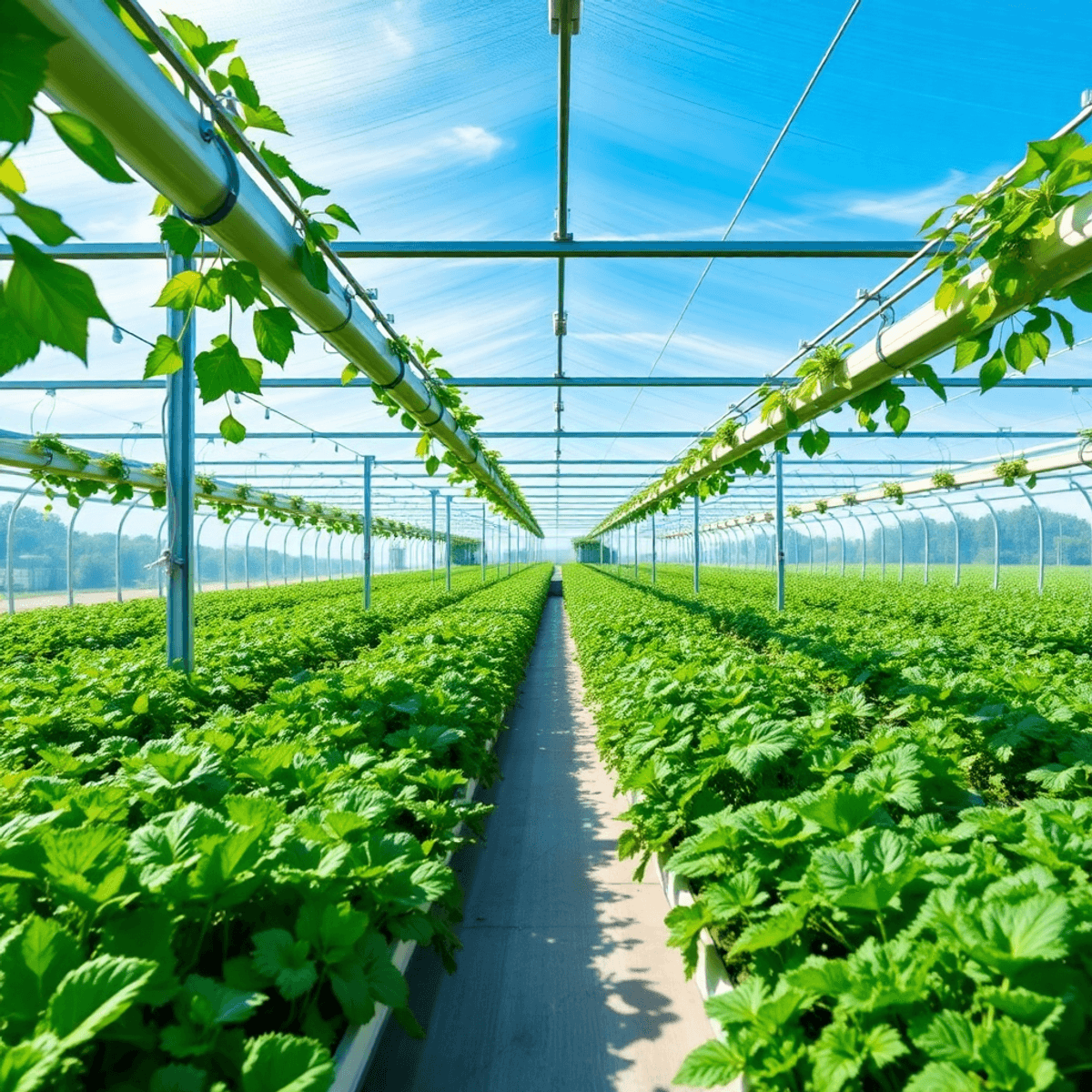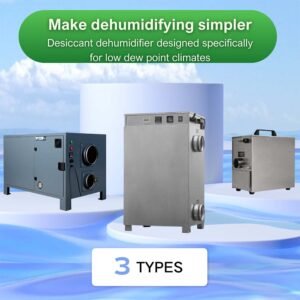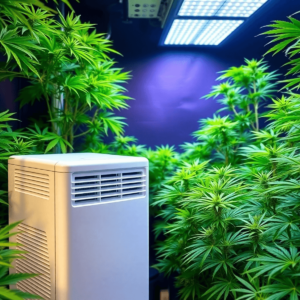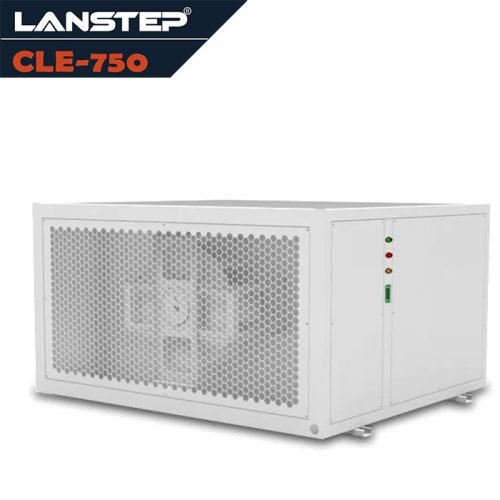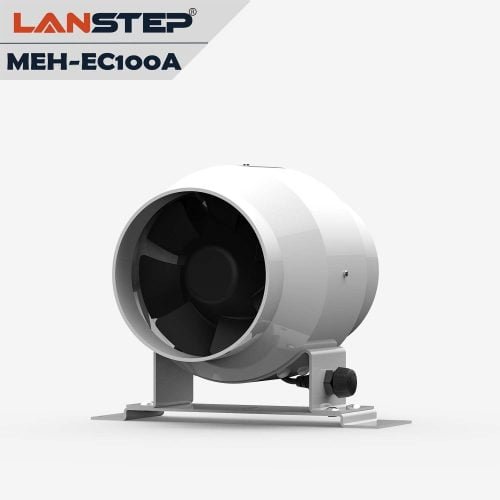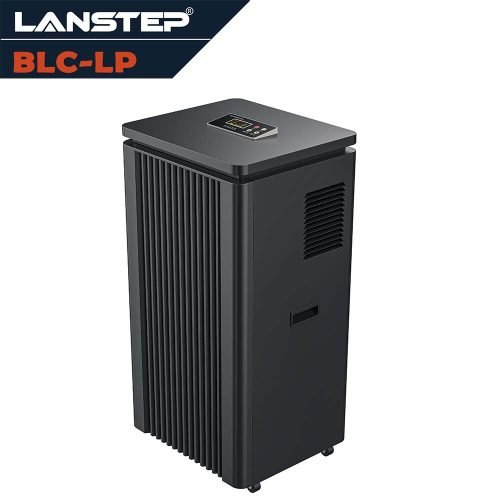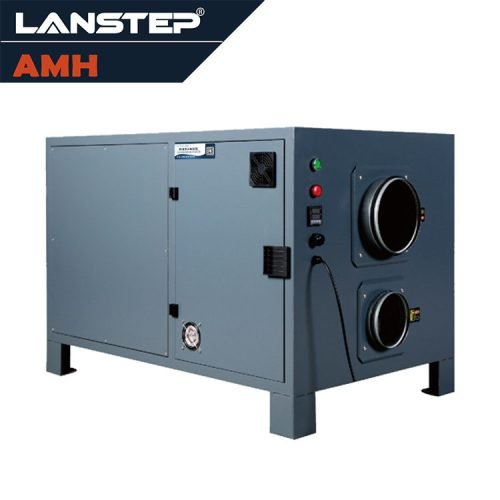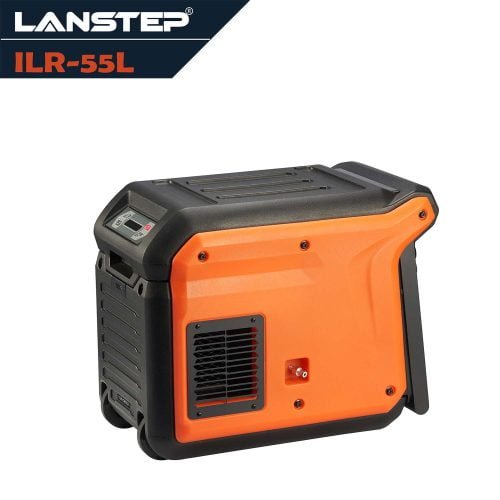Introduction
The journey from factory to consumer, known as the supply chain process, is a complex yet fascinating pathway, especially when it comes to grow room dehumidifiers. In this article, we will explore how these essential tools for controlled environment agriculture make their way into the hands of growers who rely on them to maintain optimal conditions for their crops.
Understanding the supply chain is not merely an academic exercise; it is a critical component for growers aiming to optimize their operations. By comprehending how dehumidifiers move from manufacturers to your doorstep, you gain insight into ensuring timely access to high-quality equipment. This knowledge equips you with the strategic advantage needed to make informed decisions about your agricultural investments.
Specific demand dynamics within sectors such as cannabis and greenhouse farming underscore the necessity for efficient supply chains. The rapid growth of these industries, driven by increasing legalization and consumer demand for sustainably grown products, highlights the pivotal role that reliable climate control plays in achieving success. Growers constantly seek advancements and innovations in dehumidification technology, emphasizing energy efficiency and precise climate management—demands that ripple through every link of the supply chain.
Moreover, the integration of inline duct fans into grow room setups has proven beneficial. These inline duct fans are worth considering due to their efficiency and effectiveness in managing air circulation within grow rooms. This is just one example of how understanding specific product dynamics can enhance operational success in agriculture.
As we continue our exploration into the supply chain process of dehumidifiers, it’s essential to recognize that this journey is not just about transportation and logistics. It also involves a deep understanding of various product features and market demands, which ultimately shape the supply chain landscape.
1. The Role of Grow Room Dehumidifiers in Indoor Farming
In the complex world of indoor farming, where controlling the climate is crucial, grow room dehumidifiers play a vital role. These devices are designed to keep humidity levels just right, which is essential for plants to thrive. By removing excess moisture from the air, dehumidifiers prevent issues like mold and mildew that could ruin an entire crop.
For indoor farmers, especially those growing cannabis and other plants sensitive to moisture, managing humidity is extremely important. Cannabis plants do best when their humidity levels are carefully regulated. If there’s too much moisture, mold can develop on the buds, harming both quality and quantity; if there’s too little, growth may be stunted or the plants may become stressed, preventing them from reaching their full potential.
Why Humidity Control Matters
Controlling humidity isn’t only about avoiding problems—it’s also key to making sure processes like transpiration, nutrient uptake, and photosynthesis work efficiently. Here’s how these critical processes depend on proper humidity levels:
- Transpiration: Maintaining proper humidity levels helps water move through the plants, which in turn aids in absorbing nutrients. When humidity is balanced, plants can effectively:
- Draw water from their roots
- Transport essential minerals
- Cool themselves naturally
- Maintain cellular pressure
- Nutrient Transport: The right humidity levels support:
- Enhanced root development
- Better calcium absorption
- Improved distribution of nutrients
- Reduced nutrient lockout risks
- Photosynthesis: Creating optimal conditions boosts the effectiveness of photosynthesis, leading to healthier plant growth. Proper humidity helps by:
- Keeping stomata open at ideal levels
- Supporting CO2 absorption
- Maintaining leaf surface temperature
- Preventing water stress
Key Insight: Plants grown in environments with properly controlled humidity typically show 20-30% faster growth rates compared to those in uncontrolled settings.
- Plant Defense Mechanisms: Balanced humidity strengthens:
- Natural pest resistance
- Disease prevention capabilities
- Overall immune response
- Structural integrity
- These biological processes work together in a delicate balance, with humidity serving as a crucial environmental factor that influences their efficiency and effectiveness.
Advanced Dehumidification Solutions
Dehumidifiers made specifically for indoor farming often use cutting-edge technology to tackle unique environmental challenges. The CLA-240L-CropDry Max, for example, is built for large-scale ducted dehumidification. This powerful unit can remove large amounts of moisture quickly, stopping mold in its tracks and creating perfect conditions for plants to flourish.
On the other hand, standing dehumidifiers like the ILA-168L-PlantGuard Pro offer continuous operation—an ideal feature for industrial setups where consistent moisture control is critical.
Key Features of Modern Agricultural Dehumidifiers:
- Smart Humidity Control – Automated systems maintain precise moisture levels through advanced sensor technology
- Energy Recovery Systems – Utilize heat exchange technology to reduce operational costs by up to 40%
- Remote Monitoring Capabilities – WiFi-enabled controls allow for real-time adjustments and alerts
- Industrial-Grade Construction – Corrosion-resistant materials ensure longevity in harsh growing environments
Technical Insight: Modern dehumidification units can process up to 240 liters per day while maintaining optimal relative humidity levels between 45-65% in growing spaces up to 8,000 square feet.
Advanced Operating Modes:
- Night Mode Operation – Reduced noise levels during off-peak hours
- Seasonal Adaptability – Automatic adjustments based on environmental conditions
- Crop-Specific Programs – Preset configurations for different growth stages
- Emergency Moisture Control – Rapid response systems for sudden humidity spikes
These systems incorporate dual-stage filtration and intelligent defrost mechanisms, ensuring consistent performance even in challenging conditions. The integration of variable speed fans and precision condensate pumps provides growers with unprecedented control over their cultivation environment.
Meeting Industry Demands
The specific needs of industries such as cannabis have highlighted the importance of strong dehumidification systems like LANSTEP’s commercial size dehumidifiers. These units deliver exceptional performance and can handle large spaces with ease, offering:
- Precision Control Systems – Maintain exact humidity levels within ±2% RH
- High-Volume Processing – Capable of removing up to 158 pints per day
- Smart Energy Management – Reduces operational costs by up to 40%
As more growers understand how vital it is to maintain strict environmental controls using advanced tools like the CLE Series Dehumidifiers, which provide energy-saving deep dehumidification for cannabis drying rooms, these devices are becoming essential to their operations.
Key Industry Applications:
- Commercial Cannabis Facilities – Supports multiple growing zones simultaneously
- Industrial Agriculture – Maintains optimal conditions for year-round production
- Research Facilities – Enables precise environmental control for experimental crops
“Proper humidity management can increase crop yields by up to 30% while reducing the risk of mold and pathogen growth by 80%”
The integration of these systems has revolutionized indoor agriculture by:
- Minimizing crop loss during critical drying phases
- Enhancing product quality through consistent moisture control
- Supporting compliance with industry regulations
- Reducing manual intervention through automated monitoring
This knowledge enables farmers to use technology effectively—keeping crops healthy and maximizing harvests despite the challenges posed by indoor farming conditions. Modern cultivation facilities are increasingly adopting these sophisticated systems to ensure optimal growing conditions across multiple growth cycles.
2. Exploring Different Types of Grow Room Dehumidifiers
In the world of indoor farming, choosing the right grow room dehumidifier is crucial for success. There are different types of dehumidifiers available, each designed to meet specific agricultural needs.
Mechanical and Desiccant Models: Understanding Core Technologies
Mechanical Dehumidifiers: These systems utilize a sophisticated refrigeration cycle for moisture extraction. Here’s how they operate:
- A powerful fan draws warm, humid air across cold evaporator coils
- The temperature difference triggers condensation, collecting water droplets
- Processed air passes over warm condenser coils before recirculation
- Typical efficiency ratings range from 2-4 liters per kilowatt-hour
Key Benefits:
- Excellent performance in temperatures above 20°C (68°F)
- Lower initial investment compared to desiccant units
- Minimal maintenance requirements
- Built-in air filtration capabilities
Desiccant Dehumidifiers: These advanced units employ moisture-absorbing materials for humidity control. Their operation involves:
- Silica gel or zeolite wheels that rotate through separate airstreams
- Process air passes through the desiccant material for dehumidification
- Reactivation air stream removes moisture from the desiccant
- Operating capacity of 0.5-5000 kg/hour moisture removal
Pro Tip: Desiccant systems excel in cold environments where mechanical units might struggle with frost formation.
Notable Features:
- Consistent performance at temperatures as low as -20°C (-4°F)
- Precise humidity control within ±1% RH
- No condensate handling required
- Lower operating temperatures beneficial for sensitive crops
The choice between these technologies often depends on specific environmental conditions and operational requirements within your growing facility.
Advanced Technologies Enhancing Efficiency
TPER Technology (Thermal Pump Enhanced Refrigeration): This new advancement in dehumidification technology greatly improves energy efficiency by maximizing heat release during moisture removal:
- High-Efficiency Condenser: Enlarged condenser design enhances cooling capability.
- Advanced Throttling Devices: Allow precise calculation of airflow, optimizing water condensation.
- Broader Dew Point Range Adaptability: Maintains superior performance across varying temperature conditions.
Such innovations enable TPER-equipped dehumidifiers to be up to 40% more efficient than conventional systems. However, for specific needs such as cold climates or high-capacity requirements, the AMD series desiccant dehumidifiers offer unique heat recovery technology for enhanced energy efficiency. These units are perfect for industrial warehouses, manufacturing facilities, and power stations, presenting an attractive proposition for growers focused on sustainability and cost reduction.
LANSTEP’s CLE Series: Leading the Charge in Energy Efficiency
LANSTEP has become a leader in integrating advanced technology into their dehumidification solutions. The CLE Series exemplifies this commitment, offering a range of models to suit various needs:
- Deep Dehumidification Freeze Technology: Ensures precise humidity control essential for cannabis cultivation and other sensitive crops.
- Energy Savings: Achieves impressive efficiency—extracting 9 pints of water per kilowatt-hour—which translates into significant reductions in operational costs.
- Environmental Impact: By minimizing energy consumption and maximizing resource utilization, the CLE Series reduces the carbon footprint of indoor farming operations.
Among the offerings in the CLE Series is the CLE210, a high-efficiency dehumidifier designed exclusively for grow rooms, capable of removing up to 210 pints per day at specific conditions.
LANSTEP’s emphasis on innovation not only supports growers in achieving optimal plant health but also aligns with global sustainability goals by offering environmentally friendly equipment solutions.
The journey through these technological advancements reveals the potential for growers to leverage sophisticated tools that streamline indoor farming processes while ensuring energy conservation and ecological responsibility. Understanding these options within the context of your specific agricultural needs can guide you toward making informed decisions that enhance productivity and profitability.
For instance, alongside effective dehumidification, maintaining optimal airflow is equally crucial. This can be achieved through the use of high-quality inline duct fans like INA-EC200 or MEH-EC100A. These fans are designed to improve ventilation efficiency significantly.
Moreover, understanding how to prevent issues such as white spots on cannabis plants can further enhance your gardening success.
3. The Manufacturing Process Behind Quality Grow Room Dehumidifiers
In the world of agricultural climate control, some manufacturers stand out for their skill in creating dependable dehumidification solutions. These HVAC companies are more than just manufacturers; they are forward-thinkers who recognize the importance of dehumidifiers in improving indoor farming conditions. With a focus on excellence and innovation, they continuously improve their methods to provide equipment that meets the highest standards of performance and reliability.
Key Steps in the Manufacturing Process:
- Design and Conceptualization:
- The process begins with a thorough understanding of grow room needs. Engineers and designers work together to create plans that address specific humidity control requirements.
- Integration of advanced technologies, such as TPER (Thermal Pump Enhanced Refrigeration), is considered at this stage to improve energy efficiency.
- Prototyping:
- After finalizing designs, prototypes are created to bring ideas into reality.
- These prototypes undergo extensive testing to ensure they meet desired specifications and can endure various environmental conditions.
- Component Sourcing:
- High-quality parts are obtained from reliable suppliers, ensuring that each component contributes to the overall reliability and efficiency of the dehumidifier.
- Emphasis on sustainable materials aligns with growing industry demand for eco-friendly products.
- Production:
- Manufacturing facilities equipped with modern machinery produce the dehumidifiers on a large scale, maintaining strict quality control measures throughout.
- Skilled workers in precision assembly ensure that each unit is built to exacting standards.
- Testing and Quality Assurance:
- Finished products undergo comprehensive testing protocols, simulating real-world operating conditions.
- Compliance with certifications such as ISO 9001 ensures adherence to industry-wide quality management standards, while ETL certification verifies safety compliance.
This smooth process from design to production demonstrates a commitment to creating dehumidifiers that not only meet but exceed expectations. Through careful attention to detail and ongoing innovation, these manufacturers provide growers with tools essential for successful cultivation.
For example, LANSTEP is a leading manufacturer known for its advanced dehumidification solutions and inline duct fans. Their product lineup includes portable commercial dehumidifiers, whole house dehumidifiers, industrial ducted dehumidifiers, and LGR dehumidifiers specifically designed for grow rooms. Additionally, their inline duct fans such as the MSA-EC300Z-11.5 inch EasyConnect Duct Inline Duct Fan, feature EC motors ensuring reliable and efficient exhaust from grow tents by effectively removing heat and odor.
Furthermore, LANSTEP also offers specialized models like the BLA-L-Warehouse Industrial Dehumidifier which cater specifically to warehouse needs providing efficient moisture control at affordable prices. Their continuous innovation is also reflected in their focus on enhancing cannabis growth strategies through optimized humidity levels as discussed in their article about VPD vs static humidity.
4. Ensuring Performance Reliability Through Components Sourcing and Quality Assurance
In the complex world of supply chains, finding high-quality parts is crucial for making sure grow room dehumidifiers work well and last a long time. This important factor not only affects how well these devices operate but also decides how durable they are in tough places like cannabis farms and industrial areas.
Components Sourcing: The Backbone of Reliability
A grow room dehumidifier’s effectiveness depends on how well its parts work together. Manufacturers who strive for excellence carefully choose parts that are strong and compatible with advanced dehumidification technologies like TPER (Thermal Pump Enhanced Refrigeration). The selection of components, including compressors and coils, is vital for achieving optimal humidity control while using minimal energy.
Key Considerations in Sourcing Components
When evaluating components for grow room dehumidifiers, manufacturers must carefully assess several critical factors to ensure optimal performance and longevity:
- Durability Standards
- Heat-resistant materials rated for continuous operation
- Corrosion-resistant finishes to prevent deterioration
- Impact-resistant housings for internal components
- Stress-tested parts under simulated conditions
- System Compatibility
- Standardized connection interfaces
- Voltage and amperage matching specifications
- Communication protocol alignment with control systems
- Dimensional accuracy for proper fit
- Energy Efficiency Metrics
- Components with high SEER ratings
- Smart power management capabilities
- Low-friction moving parts
- Advanced thermal transfer properties
- Material Quality
- Medical-grade polymers for moisture-sensitive parts
- Aircraft-grade aluminum for heat dissipation
- Industrial-grade copper for enhanced conductivity
- UV-resistant materials for exposed components
- Performance Verification
- Third-party testing certifications
- Real-world performance data
- Mean time between failures (MTBF) ratings
- Operating temperature range compliance
Pro Tip: When selecting components, prioritize those with documented performance histories in similar environmental conditions to ensure reliable operation in your specific application.
For instance, inline duct fans sourced from reputable manufacturers like LANSTEP can significantly enhance the efficacy of dehumidifiers by providing reliable and efficient ventilation solutions.
Quality Assurance: A Framework for Excellence
To ensure that grow room dehumidifiers meet strict industry standards, manufacturers implement thorough quality assurance protocols. Certifications such as ISO 9001 and ETL are not just symbols of achievement; they represent a manufacturer’s dedication to quality and safety.
ISO 9001 Certification: Quality Management System
This internationally recognized certification validates a manufacturer’s commitment to maintaining consistently high quality standards throughout their operations. The certification process examines several critical aspects:
- Documentation Control
- Standardized operating procedures
- Regular quality manual updates
- Traceable production records
- Process Management
- Systematic quality checks at each production stage
- Statistical process control methods
- Real-time monitoring systems
- Continuous Improvement
- Regular internal audits
- Employee training programs
- Performance metrics tracking
“ISO 9001 certification requires organizations to demonstrate their ability to consistently provide products that meet customer and regulatory requirements.”
The certification ensures that manufacturers implement:
- Risk-based thinking in operational planning
- Evidence-based decision making
- Systematic defect prevention measures
- Customer satisfaction monitoring systems
Companies must undergo periodic reassessments to maintain their certification, ensuring ongoing compliance with quality standards and adaptation to evolving industry requirements.
Key Benefits for End Users:
- Consistent product quality
- Reduced risk of manufacturing defects
- Enhanced product reliability
- Transparent quality control processes
ETL Safety Assurance: Meeting Safety Standards
ETL certification, administered by Intertek, represents a comprehensive validation of product safety and compliance with North American standards. This certification is particularly crucial for dehumidification equipment operating in controlled environments.
Key Testing Parameters:
- Electrical component safety
- Temperature rise during extended operation
- Insulation effectiveness
- Ground fault protection
- Overcurrent safeguards
The certification process involves rigorous testing protocols that examine:
- Voltage fluctuation tolerance
- Environmental stress resistance
- Emergency shutdown capabilities
- Power consumption efficiency
“ETL certification requires products to meet or exceed the requirements of UL standards while complying with regional safety codes.”
Safety Features Verification:
- Arc-fault protection systems
- Thermal overload prevention
- Moisture-resistant components
- Fail-safe operational controls
For indoor agriculture applications, ETL-certified dehumidifiers provide:
- Protected operation in high-moisture environments
- Verified safety for continuous 24/7 operation
- Documented compliance with local electrical codes
- Regular safety audits to maintain certification status
The certification extends beyond initial testing, requiring manufacturers to maintain consistent safety standards through:
- Quarterly factory inspections
- Random product sampling
- Documentation of safety modifications
- Compliance with updated safety standards
Integrating Certification into Manufacturing Processes
Manufacturers who prioritize certification demonstrate their commitment to delivering products that not only meet but exceed industry benchmarks. Incorporating ISO 9001 and ETL standards into their processes ensures:
- Consistent Product Quality: Uniformity across batches, reducing variance and enhancing reliability.
- Enhanced Customer Trust: Certifications provide customers with confidence in both the performance and safety of their equipment.
- Improved Efficiency: Streamlined processes lead to reduced waste and optimized resource use, reflecting positively on both economic and environmental fronts.
Through strategic component sourcing and adherence to rigorous quality assurance standards, manufacturers of grow room dehumidifiers position themselves as leaders in agricultural climate control technology. By focusing on these critical areas, they ensure that every product delivered stands as a testament to innovation, reliability, and excellence in an ever-evolving industry landscape.
Additionally, exploring business cooperation opportunities with established brands like LANSTEP can further enhance product offerings in this competitive market. Their expertise in manufacturing commercial dehumidifiers
5. Navigating Distribution Channels for Timely Delivery of Grow Room Dehumidifiers
The journey from manufacturer to end-user is a crucial aspect of the supply chain for grow room dehumidifiers, where efficient distribution networks play a pivotal role. The process begins with the strategic alignment between manufacturers and wholesalers, ensuring that high-quality products are readily available for further distribution. Wholesalers act as the vital link in this chain, absorbing large volumes of inventory and dispersing them across various retailers.
Key Elements of Distribution Channels:
- Manufacturers to Wholesalers: Manufacturers often collaborate with wholesalers who have robust storage facilities and logistics capabilities. This relationship ensures that grow room dehumidifiers are stored under optimal conditions, preserving their quality until they reach the next stage in the distribution network.
- Wholesalers to Retailers: Retailers rely on the efficiency of wholesalers to supply them with timely shipments. They serve as the direct point of contact with end-users, providing the necessary expertise and support to help customers select the appropriate dehumidification solutions for their needs.
Efficient logistics are paramount in this process. The ability to manage inventory levels, predict demand fluctuations, and execute timely deliveries can significantly impact customer satisfaction. A well-coordinated system minimizes delays, ensuring that growers receive their equipment when needed most—particularly during critical growth phases where environmental control is essential.
Incorporating advanced logistical strategies, such as real-time tracking and automated inventory management systems, enhances the responsiveness of these channels. This technological integration allows both wholesalers and retailers to maintain transparency throughout the supply chain, offering insights into product availability and estimated delivery times.
The importance of these distribution networks extends beyond mere transportation; they embody a commitment to reliability and excellence in service. By understanding how these channels operate, stakeholders can better appreciate the complexities involved in bringing cutting-edge dehumidification technology from conceptualization to cultivation environments across various sectors.
6. Adapting to Market Dynamics Influencing the Supply Chain Process
The supply chain of grow room dehumidifiers is undergoing a transformation due to rapid technological advancements and changing consumer expectations. One of the key trends driving this change is the rise of Controlled Environment Agriculture (CEA). As more growers adopt CEA practices to improve their crop yields and quality, the need for precise climate control solutions like grow room dehumidifiers is on the rise.
Key Market Trends
The evolving landscape of agricultural technology has given rise to several significant market trends that are reshaping the supply chain process:
- Controlled Environment Agriculture (CEA)
- The global CEA market is projected to reach $172 billion by 2025
- Vertical farming initiatives are expanding in urban areas, requiring precise humidity control
- Integration of IoT sensors with dehumidification systems enables real-time monitoring
- Advanced climate control systems are becoming standard in commercial growing operations
- Hydroponics and aeroponics facilities demand specialized moisture management solutions
- Shifts in Consumer Preferences
- Energy efficiency ratings now influence 73% of purchase decisions
- Buyers are demanding:
- Transparent carbon footprint information
- Recyclable components and packaging
- Extended product lifecycles
- Smart technology integration is becoming a key differentiator:
- Mobile monitoring capabilities
- Automated humidity adjustment features
- Energy usage tracking systems
- Technological Advancements
- Machine learning algorithms optimize dehumidification cycles
- Remote monitoring capabilities reduce maintenance costs
- Integration with building management systems
- Enhanced refrigerant technologies with lower environmental impact
- Smart sensors providing predictive maintenance alerts
- Supply Chain Digitalization
- Blockchain technology for component tracking
- Digital twin modeling for production optimization
- Real-time inventory management systems
- Automated order fulfillment processes
- Predictive analytics for demand forecasting
Industry experts note that facilities implementing modern CEA solutions see up to 40% improvement in crop yields while reducing water consumption by 90% compared to traditional farming methods.
Regulatory Influences
Regulations regarding energy efficiency and material sourcing are having a significant impact on how products are manufactured and distributed:
- Energy Efficiency Standards: Governments around the world are implementing stricter rules on energy consumption, forcing manufacturers to come up with innovative solutions. For example, technologies like LANSTEP’s CLE Series use TPER technology to meet these standards by providing superior energy efficiency and performance.
- Material Sourcing Regulations: Regulations aimed at promoting sustainability affect how materials are obtained for manufacturing processes. Manufacturers must adapt by choosing materials that comply with these regulations while still maintaining product quality and performance.
Technological Advancements
The use of advanced technologies is crucial in addressing these market dynamics:
- Advanced Dehumidification Technologies: Innovations such as TPER (Thermal Pump Enhanced Refrigeration) improve energy efficiency, allowing dehumidifiers to work effectively even in low-temperature conditions. These advancements not only meet regulatory requirements but also cater to the growing preference for sustainable solutions.
- Smart Monitoring Systems: As part of the broader shift towards automation, smart monitoring technologies enable growers to maintain precise control over environmental conditions. This capability is invaluable in CEA settings where even minor fluctuations can impact plant health.
To navigate these complex market dynamics successfully, manufacturers must be agile and forward-thinking in their supply chain strategies. By understanding these trends and adapting accordingly, they can ensure that their products reach consumers efficiently while also meeting their evolving needs and expectations.
Furthermore, it’s important to note that the political landscape can also influence market dynamics. For instance, presidential candidates who support marijuana growers could potentially impact the demand for grow room dehumidifiers as more growers enter the cannabis industry, which often requires specialized equipment for indoor cultivation.
7. Overcoming Supply Chain Challenges Faced by Grow Room Dehumidifier Manufacturers
Navigating the complex world of supply chain challenges is a tough job for grow room dehumidifier manufacturers. These challenges, often made worse by unpredictable global events, require creative solutions and flexible strategies to ensure smooth production and delivery.
Common Challenges in the Supply Chain Process
The journey from production to delivering the product to the end user is filled with obstacles. Here are some key challenges:
- Material Shortages: The availability of raw materials can be unstable, influenced by political tensions or environmental regulations. Such shortages can delay production timelines, affecting the timely delivery of dehumidifiers to customers.
- Production Timelines: Keeping efficient production schedules is crucial. Delays in any part of the manufacturing process—whether it’s due to machinery breakdowns or labor shortages—can cause significant disruptions across the supply chain.
- Disruptions from Unforeseen Events: Global events like the COVID-19 pandemic have shown how external factors can disrupt carefully planned supply chains. Lockdowns and restrictions led to factory closures and transportation delays, impacting both production capacity and distribution channels.
Impact on Costs and Product Availability
When these challenges come together, they can lead to higher costs throughout the supply chain:
- Cost Implications: Material scarcity often results in higher prices, which manufacturers may need to absorb or pass on to consumers. Additionally, expedited shipping costs incurred to meet deadlines further strain financial resources.
- Delays in Product Availability: Longer production timelines mean that end-users may experience delays in receiving essential equipment. For growers relying on precise humidity control, such delays can jeopardize crop yields and operational efficiency.
Manufacturers need to anticipate these challenges and come up with resilient strategies. By investing in diversified supplier networks, implementing robust inventory management systems, and using technology for predictive analytics, they can reduce risks and improve the reliability of their supply chains. This proactive approach not only ensures stability but also builds trust with consumers who depend on timely access to high-quality grow room dehumidifiers.
In addition to overcoming these supply chain hurdles, manufacturers must also ensure their products meet specific industry requirements. For instance, a portable dehumidifier used in a museum setting demonstrates the necessity for precise humidity control, a feature that could be crucial for certain grow room applications as well.
8. Embracing Innovations Shaping the Future of Agricultural Technology Supply Chains
Agricultural technology advancements are crucial in today’s world, and innovation is key to improving supply chains, especially when it comes to grow room dehumidifiers. Cutting-edge technologies such as automation and smart monitoring systems are completely changing the way we manage agricultural supply chains.
Automation: Streamlining Production Processes
Automation is making production processes smoother, boosting efficiency, and minimizing human mistakes. For example, automated assembly lines in dehumidifier manufacturing facilities guarantee precise and consistent output, enhancing product quality and reliability.
Key Benefits of Automation in Dehumidifier Production:
- Quality Control Systems: Advanced sensors and machine vision technology inspect components with unprecedented accuracy, ensuring each unit meets strict quality standards
- Robotic Assembly: Precision robots handle delicate components and perform complex assembly tasks with consistent accuracy
- Smart Inventory Management: Automated systems track parts and materials in real-time, optimizing stock levels and reducing warehousing costs
The integration of Industrial Internet of Things (IIoT) devices further enhances manufacturing capabilities by:
- Monitoring production metrics in real-time
- Adjusting manufacturing parameters automatically
- Predicting maintenance needs before failures occur
- Collecting valuable data for continuous process improvement
“Automation technology has reduced production errors by up to 90% while increasing output capacity by 35% in modern dehumidifier manufacturing facilities.”
These technological advances enable manufacturers to maintain high production standards while reducing operational costs. The implementation of smart manufacturing principles also allows for greater flexibility in production schedules, helping manufacturers respond quickly to market demands and supply chain fluctuations.
Smart Monitoring Systems: Real-Time Data Analytics
Smart monitoring systems are taking this a step further by offering real-time data analysis. These systems allow manufacturers to keep an eye on equipment performance throughout the supply chain, foresee maintenance requirements, and fine-tune logistics. Such knowledge leads to better decision-making, less downtime, and timely delivery of products to growers.
Key Components of Smart Monitoring:
- Sensor Networks: Advanced IoT sensors placed strategically throughout manufacturing facilities collect vital data points including:
- Temperature variations
- Humidity levels
- Energy consumption
- Production rates
- Predictive Analytics: AI-powered algorithms process collected data to:
- Identify potential equipment failures
- Optimize production schedules
- Reduce energy waste
- Streamline inventory management
“Implementation of smart monitoring systems has shown to reduce operational costs by up to 25% while improving production efficiency by 30%.”
The integration of cloud-based platforms enables manufacturers to:
- Access real-time performance metrics from anywhere
- Generate detailed reports on production efficiency
- Share data seamlessly across different departments
- Make data-driven decisions quickly
These monitoring capabilities are particularly valuable for quality control, ensuring each dehumidifier meets strict performance standards before reaching customers. The system’s ability to detect minor variations in assembly processes helps maintain consistent product quality while reducing waste and rework time.
Sustainability: A Growing Focus
The emphasis on sustainability is gaining traction among both consumers and manufacturers. This shift is clear in the increasing demand for sustainable farming practices and eco-friendly products. Energy-efficient grow room dehumidifiers are a prime example of this trend. They not only lower operational costs for growers but also reduce environmental impact by optimizing energy use.
Consider LANSTEP’s CLE Series Dehumidifiers: equipped with advanced TPER technology, they exemplify the fusion of innovation and sustainability. By maximizing heat release efficiency and condensing maximum water from the air, these dehumidifiers achieve 40% greater efficiency than traditional models. This level of performance translates into significant energy savings for growers while contributing to a reduced carbon footprint.
Additionally, ventilation plays a crucial role in maintaining optimal conditions within grow rooms. The SMC-EC200 8 Inch Silenced Inline Fans from LANSTEP are an excellent example of innovative technology in this area. Equipped with an EC motor, these fans provide efficient airflow while operating silently, making them ideal for sound insulation applications.
Commitment to Sustainability Across the Supply Chain
The dedication to sustainability goes beyond just developing products; it influences every part of the supply chain process. Companies are increasingly aligning their strategies with environmental goals by:
- Using eco-friendly materials
- Implementing green manufacturing practices
Certifications like ISO 14001 (environmental management) further emphasize this commitment, ensuring that operations follow internationally recognized standards for environmental responsibility.
As we go through these transformative times, one must ask: how can we use these innovations to reshape the future of agriculture? The answer lies in our collective ability to embrace technology that not only improves efficiency but also supports sustainability—setting a new benchmark for agricultural supply chains globally.
Conclusion: Optimizing Your Grow Room Setup With Knowledge From The Supply Chain Perspective
In the ever-changing world of indoor farming, understanding supply chain processes becomes a crucial asset for growers. By learning about the journey “From Factory to Consumer: The Complete Supply Chain Process for Grow Room Dehumidifiers”, you gain insights that go beyond simply acquiring equipment.
- Strategic Advantage: This knowledge empowers you to align your operations strategically. Recognizing how dehumidifiers are manufactured, distributed, and delivered allows for informed decisions that optimize both time and resources.
- Enhanced Efficiency: Utilizing this comprehensive understanding means being better prepared to anticipate market shifts, adapt to regulatory changes, and leverage innovations in agricultural technology. These elements contribute significantly to enhancing the efficiency and sustainability of your grow room environment.
- Optimized Operations: With an eye on the entire supply chain, you can ensure timely access to quality dehumidifiers tailored to specific crop requirements, such as cannabis or greenhouse cultivation. This not only maximizes yield but also minimizes energy consumption.
By integrating these insights into your operational strategies, you transform potential challenges into opportunities for growth and innovation in your indoor farming endeavors.
FAQs (Frequently Asked Questions)
What is the role of grow room dehumidifiers in indoor farming?
Grow room dehumidifiers are crucial for maintaining optimal humidity levels, which are essential for plant health. They help control excess moisture, particularly important in cannabis production and other indoor crops that have high moisture requirements.
What types of grow room dehumidifiers are available?
There are various types of grow room dehumidifiers used in agriculture, including mechanical and desiccant models. Advanced technologies like TPER (Thermal Pump Enhanced Refrigeration) improve energy efficiency, while models like LANSTEP’s CLE Series offer benefits such as reduced operating costs and a lower environmental impact.
How does the manufacturing process affect the quality of grow room dehumidifiers?
The manufacturing process involves several key steps from design to production, including prototyping and testing phases. Manufacturers specializing in agricultural climate control equipment ensure reliability through rigorous quality control measures.
Why is components sourcing important for grow room dehumidifiers?
Sourcing high-quality components significantly impacts the performance reliability and longevity of grow room dehumidifiers. Certifications like ISO 9001 for quality management and ETL for safety standards play a vital role in ensuring that products meet industry standards.
What challenges do manufacturers face in the supply chain for grow room dehumidifiers?
Manufacturers encounter various challenges during the supply chain process, including disruptions caused by unforeseen events like the COVID-19 pandemic. These challenges can lead to increased costs or delays in product availability for end-users.
How can understanding the supply chain benefit growers?
By leveraging knowledge of the supply chain process for grow room dehumidifiers, growers can optimize their operations. Understanding specific demand dynamics and market trends allows them to ensure timely access to quality equipment, ultimately enhancing their indoor farming success.

